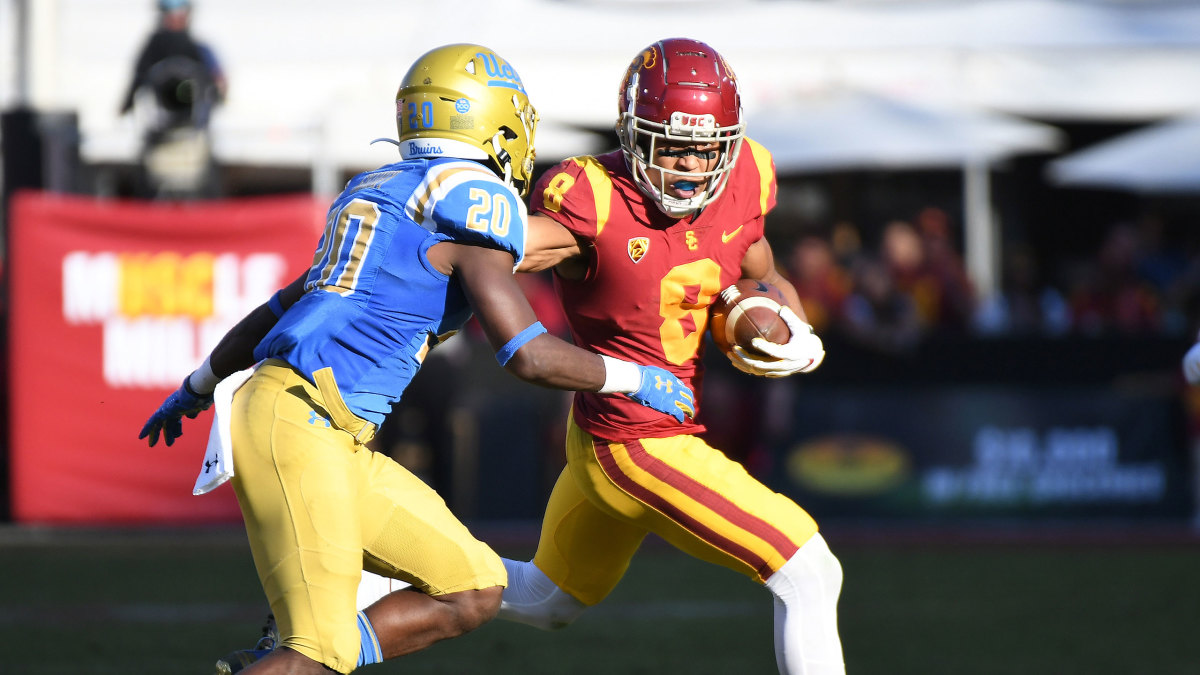The Demise of College Football in California May Have Been Greatly Exaggerated
David Shaw would like a word.
In fact, the Stanford football coach would like several words, with multiple media personalities, from a few different television networks. He’d like to tell them that they failed their audience, that they delivered the wrong message, that they misled everyone. He’d like to razz those who wrote sensational headlines, the ones projecting California football’s demise, predicting those in the Golden State would be left behind while the rest of the country played a fall season.
“There’s a lot of gamesmanship that happens in the college football world that is very pointed at us out here on the West Coast, that we don’t love football, that we don’t play real football, how if we don’t do what the SEC is doing in the way the SEC is doing it, then we’re wrong,” Shaw says in an interview with Sports Illustrated on Wednesday. “The fact that we didn’t operate the same way as a state that is one-third the size of California, doesn’t mean that we don’t take this thing very seriously.
“It was hard turning on the TV and watching some sports experts—I’m using air quotes—really say that ‘We don’t know if they’re going to play football over there and maybe all those players should transfer and hopefully this one-time transfer rule goes through!’” Shaw continues. “We took a lot of shots, and some very prominent people on some very big networks took some shots, but I’m used to it.”
Those in California are hitting back: Their demise was greatly exaggerated. They’re playing football, at least they plan to play football like everyone else. They’ve planned on it all along. Despite conjecture to the contrary, America’s most populous state is on the path for an on-time kickoff. The latest sign came Tuesday, when Pac-12 school leaders announced that players could return to campus as soon as June 15. And while it may be a long shot for UCLA, USC, Stanford and Cal to reopen facilities by that date, most feel that a July start date isn’t just possible, but is very much expected.

Holding the most conservative of approaches to reopening, California is showing significant signs of progress. For instance, last week, Gov. Gavin Newsom said the state’s professional sports teams could play without crowds as soon as June. And then on Wednesday, he suggested a plan for reopening gyms in the state could be released within the next week. Meanwhile, much of the state is more than halfway through the four-phase, regional reopening process.
In Los Angeles, USC coach Clay Helton can take a stroll along the beaches or down hiking paths, both now reopen, and in Berkeley, Cal coach Justin Wilcox can order takeout from his favorite local eatery. Down south, San Diego State athletic director John David Wicker can now get a trim at his local barbershop or dine inside a restaurant. Maybe most important, he chuckles, his wife can now visit one of her favorite places—the nail salon.
The point is, California, though behind many other states, is advancing rapidly enough to give those there confidence in playing football. That includes marquee early-season games—USC against Alabama in Dallas and TCU at Cal—that many believed to be in jeopardy just days ago. “We’re extremely optimistic that we’re going to play a 12-game season. I’m excited about the opportunity to play Alabama, a rivalry game like Notre Dame and a nine-game conference schedule,” says Helton. “Things are trending in the right direction. We’re seeing progress.”
Still, there are hurdles to cross in California that places like Arkansas and Texas don’t have. The Golden State is one of 12 in the U.S. still under a shelter-at-home order. It is opening on a county-by-county level, each county having to meet public health guidelines before moving on to the next stage. California’s four Pac-12 schools are located in LA, Santa Clara and Alameda counties, populated regions that are opening slower than others. While many counties in the state are moving to Stage 3 of reopening—gyms, theaters, salons, etc.—those three counties remain in Stage 2.
What’s that mean? The Trojans, Cardinal, Bears and Bruins may not begin their voluntary workouts on June 15—or even in June at all. “We may be slightly behind other people,” Helton says. “I hope it’s not too much, but it’s something that if everybody has the month of July and then training camp in August, I think we’ll be on good pace.”
“I think June 15 is optimistic for a lot of us on the West Coast, not impossible but optimistic,” Shaw says. “As long as we’re back in at some point during the month of July, we won’t be far behind.”
California might not be at such a disadvantage. For starters, voluntary workouts are focused on small group weight-lifting and conditioning work, with on-field coaches strictly prohibited from interaction. Secondly, start dates for voluntary workouts will vary by school, determined by each state’s guidelines and each campus’s approach. For instance, Wyoming plans to start welcoming back athletes June 1, while Oklahoma has announced a July 1 start. Most SEC schools are starting June 8, and many from the Big 12 could begin as early as mid-June. However, some Pac-12 programs plan to start training likely ahead of their conference brethren. Arizona State and Utah have both announced plans to reopen facilities starting June 15.
“I don’t think another school should have to be penalized because we can’t go back,” says UCLA coach Chip Kelly. “You can’t sit here and say, ‘We’re not going back so they can’t go back.’ That’s not fair either. There is no fair in this. It’s a unique situation we’ve all been put in. I think we all have to bite our tongue. When you hear somebody complaining about the inequalities of how college football is being treated and you turn on the news and read about 100,000 deaths in the United States … we’ll be O.K.”
At San Diego State, Wicker announced a football start date of July 7. While that’s one of the latest such publicized, he believes the Aztecs will have plenty of time to prepare for kickoff. At San Jose State, football’s return could come deeper into July as well, says athletic director Marie Tuite. “We’re not looking at the possibility of returning athletes until much later in the summer, if at all.” If at all? “Someone tomorrow could say no sports until there’s a vaccine,” she says. “It’s a changing landscape. Athletic directors aren’t going to decide that. State, city and county officials will.”
NCAA leaders have agreed that, optimally, a football team should hold six weeks of training before kicking off. At minimum, a team needs four weeks. June workouts are the first in what officials are considering a four-step process to starting the season: 1) voluntary workouts in June; 2) workouts in early-to-mid July with coaching interaction; 3) two weeks of NFL-style OTAs in late July; 4) and a mandatory four-week camp in August.
Just two weeks ago, many feared that California schools would have issues completing four weeks of practice before a Labor Day weekend kickoff. Alarmist headlines buzzed with their doubts. “Will California ruin college football for the rest of us?” a Kentucky-based outlet asked. California “might squash college football in 2020,” said another in Michigan. Says Tuite: “Headlines were wrong.”
Meanwhile, in California, coaches had to smother fires with panicked parents and players who, after seeing reports in the media, expressed concern that the state’s cautious reopening strategy may cost them or their child a year of eligibility. Players at both UCLA and Stanford approached their head coaches with worry. “A lot has been written about California and much of it has been off base,” says Mike Bohn, athletic director at USC.
Coaches tried to brush it aside or ignore the buzz all together. “I think a lot of people say a lot of different things,” Wilcox says. “I don’t pay attention too much unless it’s factual. There’s a ton of rhetoric out there. We all want to make sure we do this thing right, but for people to opine on it who don’t have the information, then it’s just somebody’s opinion.”
For a good week, the wave of speculation rolled, triggered by three news events surfacing on the same day, May 12—two of which never materialized: SEC and ESPN TV personality Paul Finebaum revealed that Alabama was exploring a contingency plan to play TCU if USC couldn’t suit up for the game (administrators denied it); Los Angeles County’s stay-at-home order was recommended to be extended through August (those recommendations were eventually truncated); and, most notably, the California State University system announced its campuses would be closed to in-person classes this fall.
The last bit of news gripped the college football world. However, no Pac-12 programs are part of the CSU system, and the three Mountain West schools that are—San Diego State, San Jose State and Fresno State—all planned and still plan to play football this fall. Wicker’s phone incessantly buzzed that morning with messages from other athletic directors with news that shocked him. So you’re not playing football!? “I don’t think the CSU plan was rolled out as effectively as it could have been,” Wicker says. “The narrative got out of control. We had planned to have virtual learning, but we’ll have students on campus. We’ll have dorms open. There just won’t be as many students on campus attending classes. It was frustrating. We talked to all of our kids and our recruits and let them know that we plan to bring you back to campus, and if you’re a freshman, you can live in the dorms.”
The news filtered to other programs, those that don’t even fall under the umbrella of the CSU system. “When that came out,” Kelly says, “we talked as a staff and then all of our coaches handled it in their position meetings and said, ‘This is how it affects us.’ It didn’t affect us. We’re in the UC system, but it certainly caught everybody’s attention.”
California wasn’t only targeted by the media and fans, but conference commissioners and school administrators were suggesting that they weren’t waiting for the Golden State. “If California is not playing football but everyone else is, do we still play? My guess is we would play,” American Athletic Conference commissioner Mike Aresco told SI in an interview earlier this month. Pac-12 commissioner Larry Scott says he understands the nation’s sentiment toward California and the West Coast. The virus first originated in the U.S. in the state of Washington. California was the first state, in fact, to issue a stay-at-home order. “I do think there was a lasting impression because of how early that the states went to a more conservative approach here,” Scott says.
Now, months after the first outbreaks on the West Coast and days after the country dismissed California football, the Golden State is primed to play this fall—they think. “There’s not one person out there that knows what’s going to happen,” says Kelly. “That’s the one thing I am convinced of—and I’m not convinced of much else.”
More From SI.com Team Sites:
How Does College Football Restart? Jim Mora Weighs In
Larry Scott Confident Season Will Be Held, But Warns of Empty Stadiums
